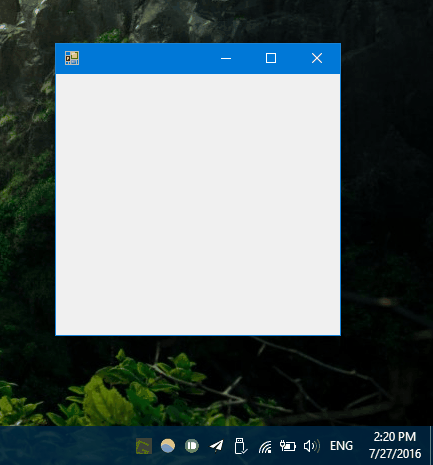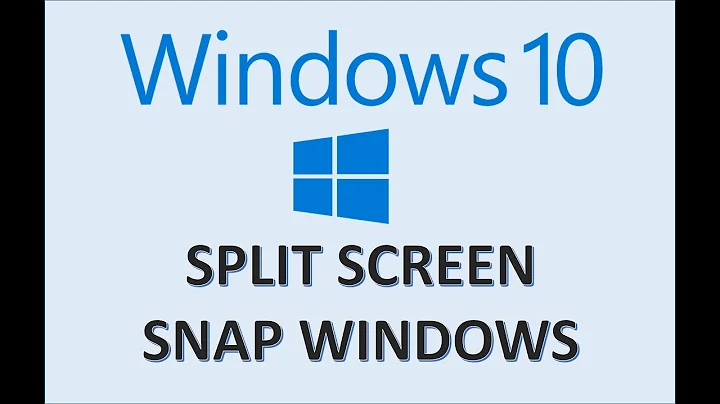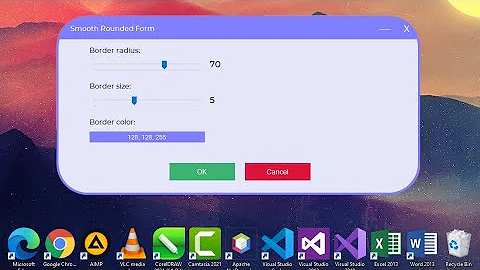How to make my Windows Form app snap to screen edges?
Solution 1
This worked pretty well, works on multiple monitors, observes the taskbar:
public partial class Form1 : Form {
public Form1() {
InitializeComponent();
}
private const int SnapDist = 100;
private bool DoSnap(int pos, int edge) {
int delta = pos - edge;
return delta > 0 && delta <= SnapDist;
}
protected override void OnResizeEnd(EventArgs e) {
base.OnResizeEnd(e);
Screen scn = Screen.FromPoint(this.Location);
if (DoSnap(this.Left, scn.WorkingArea.Left)) this.Left= scn.WorkingArea.Left;
if (DoSnap(this.Top, scn.WorkingArea.Top)) this.Top = scn.WorkingArea.Top;
if (DoSnap(scn.WorkingArea.Right, this.Right)) this.Left = scn.WorkingArea.Right - this.Width;
if (DoSnap(scn.WorkingArea.Bottom, this.Bottom)) this.Top = scn.WorkingArea.Bottom - this.Height;
}
}
Solution 2
The accepted answer only snaps the window after finishing the drag, whereas I wanted the form to continuously snap to the screen edges while dragging. Here's my solution, loosely based off the Paint.NET source code:
using System;
using System.ComponentModel;
using System.Drawing;
using System.Runtime.InteropServices;
using System.Windows.Forms;
namespace Whatever
{
/// <summary>
/// Managed equivalent of the Win32 <code>RECT</code> structure.
/// </summary>
[StructLayout(LayoutKind.Sequential)]
public struct LtrbRectangle
{
public int Left;
public int Top;
public int Right;
public int Bottom;
public LtrbRectangle(int left, int top, int right, int bottom)
{
Left = left;
Top = top;
Right = right;
Bottom = bottom;
}
public Rectangle ToRectangle()
{
return Rectangle.FromLTRB(Left, Top, Right, Bottom);
}
public static LtrbRectangle FromRectangle(Rectangle rect)
{
return new LtrbRectangle(rect.X, rect.Y, rect.X + rect.Width, rect.Y + rect.Height);
}
public override string ToString()
{
return "{Left=" + Left + ",Top=" + Top + ",Right=" + Right + ",Bottom=" + Bottom + "}";
}
}
/// <summary>
/// A form that "snaps" to screen edges when moving.
/// </summary>
public class AnchoredForm : Form
{
private const int WmEnterSizeMove = 0x0231;
private const int WmMoving = 0x0216;
private const int WmSize = 0x0005;
private SnapLocation _snapAnchor;
private int _dragOffsetX;
private int _dragOffsetY;
/// <summary>
/// Flags specifying which edges to anchor the form at.
/// </summary>
[Flags]
public enum SnapLocation
{
None = 0,
Left = 1 << 0,
Top = 1 << 1,
Right = 1 << 2,
Bottom = 1 << 3,
All = Left | Top | Right | Bottom
}
/// <summary>
/// How far from the screen edge to anchor the form.
/// </summary>
[Browsable(true)]
[DefaultValue(10)]
[Description("The distance from the screen edge to anchor the form.")]
public virtual int AnchorDistance { get; set; } = 10;
/// <summary>
/// Gets or sets how close the form must be to the
/// anchor point to snap to it. A higher value gives
/// a more noticable "snap" effect.
/// </summary>
[Browsable(true)]
[DefaultValue(20)]
[Description("The maximum form snapping distance.")]
public virtual int SnapDistance { get; set; } = 20;
/// <summary>
/// Re-snaps the control to its current anchor points.
/// This can be useful for re-positioning the form after
/// the screen resolution changes.
/// </summary>
public void ReSnap()
{
SnapTo(_snapAnchor);
}
/// <summary>
/// Forces the control to snap to the specified edges.
/// </summary>
/// <param name="anchor">The screen edges to snap to.</param>
public void SnapTo(SnapLocation anchor)
{
Screen currentScreen = Screen.FromPoint(Location);
Rectangle workingArea = currentScreen.WorkingArea;
if ((anchor & SnapLocation.Left) != 0)
{
Left = workingArea.Left + AnchorDistance;
}
else if ((anchor & SnapLocation.Right) != 0)
{
Left = workingArea.Right - AnchorDistance - Width;
}
if ((anchor & SnapLocation.Top) != 0)
{
Top = workingArea.Top + AnchorDistance;
}
else if ((anchor & SnapLocation.Bottom) != 0)
{
Top = workingArea.Bottom - AnchorDistance - Height;
}
_snapAnchor = anchor;
}
private bool InSnapRange(int a, int b)
{
return Math.Abs(a - b) < SnapDistance;
}
private SnapLocation FindSnap(ref Rectangle effectiveBounds)
{
Screen currentScreen = Screen.FromPoint(effectiveBounds.Location);
Rectangle workingArea = currentScreen.WorkingArea;
SnapLocation anchor = SnapLocation.None;
if (InSnapRange(effectiveBounds.Left, workingArea.Left + AnchorDistance))
{
effectiveBounds.X = workingArea.Left + AnchorDistance;
anchor |= SnapLocation.Left;
}
else if (InSnapRange(effectiveBounds.Right, workingArea.Right - AnchorDistance))
{
effectiveBounds.X = workingArea.Right - AnchorDistance - effectiveBounds.Width;
anchor |= SnapLocation.Right;
}
if (InSnapRange(effectiveBounds.Top, workingArea.Top + AnchorDistance))
{
effectiveBounds.Y = workingArea.Top + AnchorDistance;
anchor |= SnapLocation.Top;
}
else if (InSnapRange(effectiveBounds.Bottom, workingArea.Bottom - AnchorDistance))
{
effectiveBounds.Y = workingArea.Bottom - AnchorDistance - effectiveBounds.Height;
anchor |= SnapLocation.Bottom;
}
return anchor;
}
protected override void WndProc(ref Message m)
{
switch (m.Msg)
{
case WmEnterSizeMove:
case WmSize:
// Need to handle window size changed as well when
// un-maximizing the form by dragging the title bar.
_dragOffsetX = Cursor.Position.X - Left;
_dragOffsetY = Cursor.Position.Y - Top;
break;
case WmMoving:
LtrbRectangle boundsLtrb = Marshal.PtrToStructure<LtrbRectangle>(m.LParam);
Rectangle bounds = boundsLtrb.ToRectangle();
// This is where the window _would_ be located if snapping
// had not occurred. This prevents the cursor from sliding
// off the title bar if the snap distance is too large.
Rectangle effectiveBounds = new Rectangle(
Cursor.Position.X - _dragOffsetX,
Cursor.Position.Y - _dragOffsetY,
bounds.Width,
bounds.Height);
_snapAnchor = FindSnap(ref effectiveBounds);
LtrbRectangle newLtrb = LtrbRectangle.FromRectangle(effectiveBounds);
Marshal.StructureToPtr(newLtrb, m.LParam, false);
m.Result = new IntPtr(1);
break;
}
base.WndProc(ref m);
}
}
}
And here's what it looks like:
Solution 3
Just retrieve the current pixel height/width of the monitor you're on...
How to determine active monitor of the current cursor location
... and process the location changed/moved events for the form. When you get within, say 25 pixels or so of an edge (your main form's Location.Left + form width) or height (your main form's Location.Top + form height), then go ahead and set the .Left and .Top properties so that your application "docks" in the corners.
Edit: One other note - when you actually do the "snapping" you may also want to move the cursor position the relative distance to make it stay on the same point on the window bar. Otherwise your form may become a giant ping pong ball between the cursor position and your "snappy" functionality as the MouseMove and form location changed events fight against each other.
Related videos on Youtube
erator
Updated on July 09, 2022Comments
-
 erator almost 2 years
erator almost 2 yearsAnyone out there know how to make your .net windows form app sticky/snappy like Winamp so it snaps to the edges of the screen?
The target framework would be .NET 2.0 Windows Form written in C#, using VS08. I am looking to add this functionality to a custom user control, but I figured more people would benefit from having it described for the application and its main form.
Thank you.
-
Hosam Aly about 15 yearsPlease take into account that the taskbar may have different properties (top, bottom, right, left, multiple rows, different font size, etc.). You may also want to account for the gadgets bar in Windows Vista. Moreover, you may want to handle changes to screen resolution or taskbar size.
-
Hosam Aly about 15 yearsAnother thing to put into consideration is to allow the user to move the window outside the screen borders. Many times I move a window outside the screen borders to have only a small part of it visible.
-
-
Neil N about 15 yearsthe only problem with that is once your docked you can never leave. Be sure to allow for a mouse move, (i.e. click and drag 25 pixels) once docked that can undock your form.
-
Brandon about 15 yearsIf that were desired functionality, you could call it a "Docking Hotel California".
-
MarkJ about 15 yearsDon't you think you should allow for the taskbar and other toolbars rather than obscuring them?
-
Mike Perrenoud over 10 yearsDoes this change the screens working area too so that the maximum usable space on the desktop is reduced (i.e. maximized windows wouldn't go on top)?
-
 faza over 7 yearsworks just like a charm! :) and If you want limit the user to place the form all on the screen (to not exceeding the working area) just change this line:
faza over 7 yearsworks just like a charm! :) and If you want limit the user to place the form all on the screen (to not exceeding the working area) just change this line:return delta > 0 && delta <= SnapDist;to:return (delta < 0) || (delta > 0 && delta <= SnapDist); -
סטנלי גרונן about 7 yearsIt wouldn't be a bad idea to give also some details, comments, explanations, etc. not only code, SO users will benefit more in the future. Just a thought :)
-
stax76 about 7 yearsI'm not good in writing comments, somebody sent the code as pull request to staxrip and I made it much shorter removing all comments and other things, after creators update it was broke so I fixed it, people can use a recent staxrip test build to test it. The original pull request is here: github.com/stax76/staxrip/pull/5







